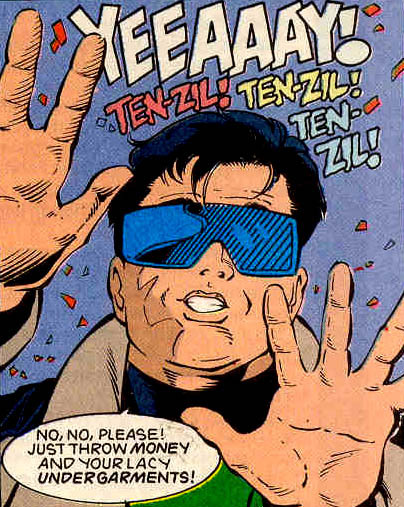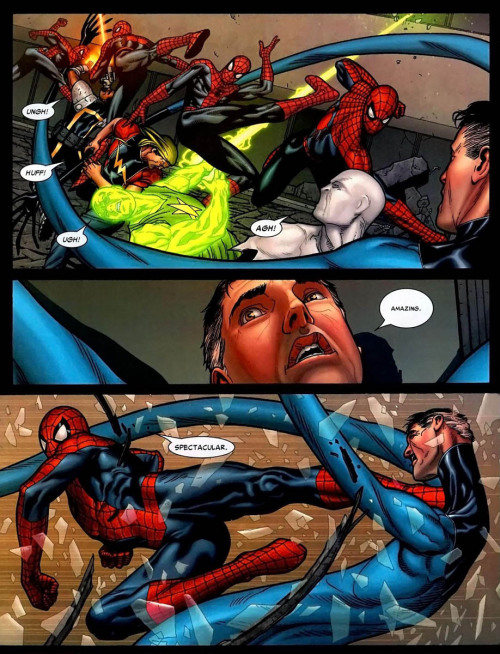Tactical Superheroes?
 |
| This superhero is a tactical genius |
The other end, my current gamesystem Marvel Heroic Roleplaying, whose abstract gameplay means I could probably play in my living room without a table at all.
Why is tactical gaming valuable, not just in superhero games, but in most games? For me, the benefit became obvious when I once had a player whose character seemed to be everywhere. Watching the door, checking the chest for traps, and looting the bodies. Whatever could be done, her PC was there. Being able to say, "no, you're here" is pretty helpful.
In addition, there's the "wait, what's going on" factor. When you have a half-dozen players who aren't always paying attention, or may be going to the bathroom, etc. being able to glance at the table and get a handle on what is happening at that moment. It would be nice to not have to consider that option, but I think that's just a natural limitation.
The downside to tactical gaming is that you are essentially letting the rules have more say in what a player can and can not do. Can he get close enough to the villain to hit them? The rules will show that, because you'll be moving a miniature X number of inches or hexes or squares to see. Frankly I think in the superhero genre this unfairly penalizes PC's with hand-to-hand abilities over those with ranged abilities. There's a reason why we invented guns--they allow us to hit more people in combat.
In superhero comics, characters seem to be able to move around fairly freely, without a lot of regard to how far exactly they can go. Take a look at this panel from Civil War.
This is, by the way, one of my favorite pages in the whole Civil War. You can see, in this scene, why Spider-Man is one of the iconic heroes in the Marvel universe. But anyways, Spider-Man moves through a crowd of opponents, clocking each of them in turn. Think about what would be required to make this happen in a crunchy, rules-heavy tactical game. In MHR, Spider-Man is just using the SFX Area Attack, risking a lot of dice ending up in the Doom Pool, or one of the opponents using their resistance die against Spider-Man in turn.
Put another way, in a conversation with one of my prospective players, the player asked "how does [MHR] handle super-speedsters?" In a lot of games having super-speed is a handy way to have multiple actions when other players only have one. That's a pretty obvious power-gaming option. In MHR, you might get the SFX Area Attack or "Machine Gun Punches" (see Speed, the NPC from the Civil War Event Book). But you'll only get one real roll. No making the other players wait even longer between their own turns, etc.
And, if the players have to just pay closer attention, so be it.



Playing devil's advocate here, I think you illustrate one of the biggest issues my players have in regards to the non-tactical Superhero RPGs such as MHR - Does what I do/think of matter?
ReplyDeleteOne of the players in my old Champions gaming group came up with what has to be one of the coolest super-speedster heroes of all time...Godspeed.
In addition to flat out Superpseed and a high Speed score (enabling him to go multiple times per round), Godspeed had a Speed Power Pool, which allowed him to do crazy stunts as long as he could explain them as speed. A huge Flash fan, that was no problem for the player, Nelson.
Now, one of his favorite tricks, even early in the campaign, was to spend all his power points and purchase his Speed Score higher using his pool. At one point he could have a Speed of 12, thereby moving every phase in a round. Later, he could move at Speed 24, essentially giving him a move each phase and between each phase.
Sure it's power-gamey, sure it made the round take a while but now, many years later, we all still remember and talk about Godspeed. Remember how he would take out all 12 armed goons that one time leaving the big baddie for our Superman-type and Dr. Strange-type heroes? Remember the time he took the evil mad scientist villain's machine apart piece by piece in one round while the rest of us battled the robot?
Nelson loved that he figured out how to do this.
Now fast forward (heheh) to MHR. All the moves are the same move. A smart fellow with a speedster is going to use Machine Gun Punches, get one roll and hopefully take out multiple opponents. So is a not so smart player. There are very few tricks to be pulled, since everything but everything works basically the same way.
Now don't get me wrong, I like MHR, A LOT! I think it's tons of fun. But, do the players get the same feeling playing it over time, in a campaign, that they would get from figuring out the ins and outs of both the system and their characters in a game like Champions.
As a buddy of mine said when MHR first came out, "It really feels like your playing in a comic book. That's awesome if you're a comic fan. But is that what a Supers GAMER wants?"
Depends on the gamer.
One of my major issues with MHR is the question of long-term playability. Frankly, I don't think it's there, or at least it isn't easily to be had. And I haven't seen any indication on the blogosphere that I'm wrong, say in the form of someone saying "we've been playing MHR for six months now and it's been great!"
DeleteWhy? Because after a while I think it will look like this:
The player rolls a d10 (affiliation)+d8 (scene or PC distinction)+d8 or d10 (power)+d8 or d10 (specialty).
Lather, rinse, repeat.
Yes, you're arguing why your deliberately broad distinction applies here (and I'm a little bemused by the game's suggestion that distinctions don't have broad applications) and you're getting the additional d8 from your stunt die from that time you rolled a "1" earlier and maybe that makes a difference, but I can see after a while it just becomes the same die rolling, time and time again.
So now I'm arguing both sides, I guess.
Coming to this a bit late but thought I would chime in anyway:
ReplyDeleteOf all the RPG genre's out there, I think Supers is the one where non-tactical combat makes the most sense. I don't know that I really need a map marked in 6' hexes or 5' squares when half of my PC's can fly at Mach 1 or run 100mph. In something like D&D getting an extra 5 or 10' of movement can be critical, but running the Avengers or the Justice League it just isn't. I typically play it without a table & a map specifically to keep the players from getting back into D&D mode.
Now I played Champions for years and would happily do so again, tac maps and all, but some games are different and it's fun to experiment with changing up how you approach them.